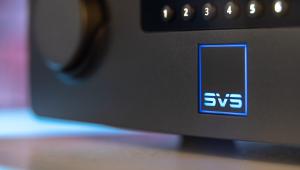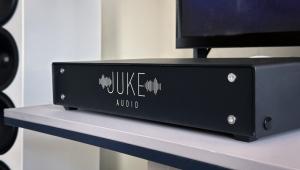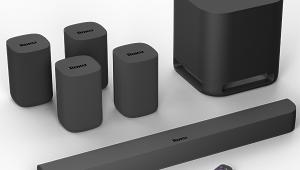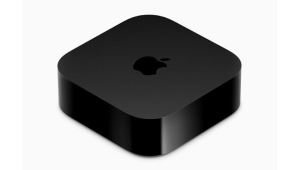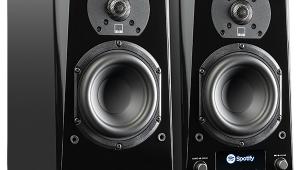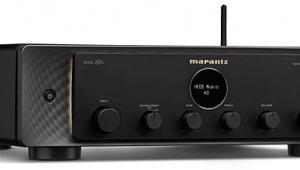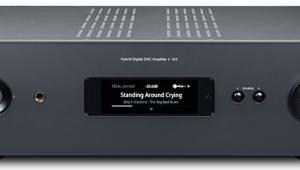Review: Aperion Aris Wireless Windows Speaker Page 2
Performance (and a friendly Showdown)
So, back to that big box. I figured it couldn't hurt to run through Aperion's suggested test (I put the supplied Sansa player aside however, using in its place my own iPad, playing back lossless files); I relied on the units' analog auxiliary inputs for comparisons; switching wirelessly (and from a DLNA server app over to AirPlay in the process) introduced too much of a delay to make any sort of reasonable judgements.
Once I matched output levels, the Aris held up quite well against the Zeppelin. The comparison does makes some sense, despite the fact that the Zeppelin is a 30-pin iOS dock (which plenty of the iPhone 5-less among us still enjoy having), since the units' overall sound signatures are not totally dissimilar - A good helping of the midbass, nice clarity on top. Like the Zeppelin, the Aris can play almost unreasonably loud for a small room; you'll probably reach the point of discomfort before you get to the Aris' limits.
I began by listening to the Aris in "Natural" mode, which gave me a midrange that sounded smoother and less nasal than the Zeppelin, and a more focused bass, but the Zeppelin had a bit more air on top (tape hiss on Kenny Burrell's Midnight Blue was more evident, for example, if you like that kind of thing) and a wider apparent soundstage. Neither speaker really wanted for either low end or sparkle, however - these units may be a bit bass-heavy, but they aren't voiced darkly in general. Both handled the bass-heavy opening of Holly Cole's take on Tom Waits' "Train Song" with aplomb; the Aris had a slight edge in articulation, with more of the body of the instrument apparent. The Zeppelin sounded bigger, but a little more diffuse, with Cole's vocal a bit submerged by comparison with the bass.
Basically the Zeppelin is a little boxier sounding, and the bass is boomier than the Aris'. the Aris also sounded (to my ear at lest) like it was putting out more energy all the way through the midrange and on up, say from 1 through 5 kHz or so; horns, vocals (from Cole to Ray Davies to Brian Ferry to Gillian Welch), and guitars both electric and acoustic all had a bit more presence and felt more forward in the mix than they did in the B&W presentation. That perhaps contributes towards the Aperion sounding a tad smaller than the Zeppelin at reasonable levels (The B&W's EQ profile does sound subjectively bigger and "louder" at moderate volumes), but to my ear the Aperion sounds more pristine and uncolored than the B&W. And its definitely more than competitive in terms of sheer volume.
Switching the Aris over to "Expanded Stereo" mode got it sounding closer to the Zeppelin (though the Zepp is using actual distance between the drivers rather than DSP to provide its stereo image); perhaps because it made the significantly narrower Aperion unit sound a bit wider than its actual dimensions. But it's not the best-sounding of the Aris' modes, in my opinion. Listening to the Arne Domnérus band's take on "Mood Indigo" from Jazz at the Pawnshop, Egil Johansen's cymbals and the top end of Bengt Hallberg's piano picked up an artificial sheen which disappeared when I switched back to the Natural setting. I didn't really enjoy that phasey edginess, though admittedly you get used to it pretty quickly as your brain fills in the gaps. The effect isn't done poorly, as these things go, though I personally could do without it. I preferred the "Natural" setting, and left it set there for most of my listening, though it made me the most aware of the Aris' size limitations.
Similarly, I didn't really feel the Aris' third mode - Bass Boost - was altogether necessary. This thing has plenty of low-end to begin with (given its dimensions, it really puts out a difficult-to-fathom amount of bass when you crank it up). I fired up a couple of bass-heavy tunes: Talking Heads' "Great Curve" (from Remain in Light) and Kip Hanrahan's "Jes' Grew" (from Conjure: Music for the Texts of Ishmael Reed), and found that both Tina Weymouth's minimal bassline on the former and Jamaladeen Tacuma and Steve Swallow's busy, dueling lines on the latter all had plenty of slam and clearly audible tone and musical content without the Boost; while activating the mode certainly gave me more bass, the tune sounded more in balance without it.
I'd say the Aris more than holds its own against the Zeppelin, but maybe comparisons are just a distraction. The thing stands pretty well on its own merits as well.

